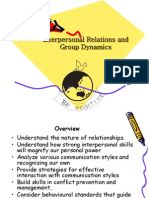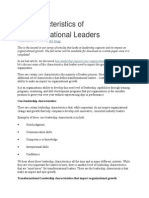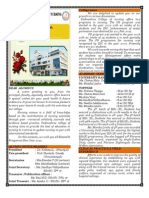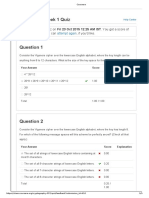Leadership
Leadership
Uploaded by
ARUN JOSE (08156864174)Copyright:
Available Formats
Leadership
Leadership
Uploaded by
ARUN JOSE (08156864174)Original Description:
Copyright
Available Formats
Share this document
Did you find this document useful?
Is this content inappropriate?
Copyright:
Available Formats
Leadership
Leadership
Uploaded by
ARUN JOSE (08156864174)Copyright:
Available Formats
LEADERSHIP
CONCEPTS
Leader is a part of management and one of the most significant elements of direction. A
leader may or may not be manager but a manager must a leader. A manager as a leader must lead
his subordinate s and also inspire them to achieve organizational goals. Thus leadership is the
driving force which gets the things done by others.
Leadership represents an abstract quality in a man. It is a psychological process of
influencing followers or subordinates and providing guidance to them. Thus the essence of
leadership is follower ship. It is the followers who make a person as leader. An executive has to
earn followers. He may get subordinates because he is in authority but he may not get a
follower unless he makes the people to follow him only willing followers can and will make him
a leader.
DEFINITON
LEADER
A person who demonstrates and exercise influence and power over others. Leaders have a vision
and influence others by their actions and comments.
LEADERSHIP
Leadership is the ability to influence other people
Lansdale
Leadership is the ability of a manager to induce subordinate to work with zeal confidence.
Koontz and O Donnell
Leadership as the ability to secure desirable actions from a group of followers voluntary, without
the use of coercion.
Afford and Beaty
Leadership is the activity to persuade others to seek defined objectives enthusiastically. It is the
human factor which binds a group together and motivate it towards goals
Keith Davis
Leadership is the lifting of mans vision to higher sights, the rising of mans performance to higher
standard, the building of mans personality beyond its normal limitation.
Peter Drucker
BY Mr. ARUN PIRAVOM ( arunpiravom1986@yahoo.in)
IMPORTANCE-
a) LEADERS MOTIVATES PEOPLE
A leader motivates employees for
higher output through motivational techniques. The leader himself acts as a motivating
factor.
b) LEADER COUNSELS EMPLOYEES
In an organization people needs counseling to reduce the emotional
disequilibrium and to remove barriers to effective performance. A leader solves such
types of problems and makes employees happy. Thus, a leader acts as a counselor.
c) LEADER DEVELOPS TEAM SPIRIT
A leader creates confidence in his subordinates and gains their faith and
cooperation. Besides, the leader provides environment conductive to work which results
in team spirit.
d) LEADERS AIMS AT TIME MANAGEMENT
Leader is in a position to utilize time productivity in an organization. A leader gets things
done by people by the proper time management.
e) LEADER STRIVES FOR EFFECTIVENESS
A leader brings effectiveness to an organization by providing the workers with the
necessary resources in terms of money, methods, climate, work environment, etc.
FUNCTIONS OF LEADERSHIP-
Executive, Planner, Policy maker, Expert, External group representative, Controller of
internal relation, Purveyor of rewards and punishment
TYPES OF LEADERSHIP
a) INTELLECTUAL LEADER
He is one who possesses rich knowledge and technical competence. All his
subordinates listen and follow his advice because of his specialized intellectual authority.
e.g.- financial advisor, legal advisor, etc
b) CREATIVE LEADER
BY Mr. ARUN PIRAVOM ( arunpiravom1986@yahoo.in)
Creative leader uses the technique of ‘circular response’ to encourage ideas to
flow from group to him and vice versa. He draws out the best in his followers and
controls them with zeal to attain the goals.
c) PERSUASIVE LEADER
He gains faith and confidence from his followers. He possesses a magnetic
personality which attracts followers which helps to get work done by them effectively.
d) INSTITUTIONAL LEADER
When a person becomes a leader by virtue of his position, he is called an
institutional leader. e.g. - the principal of a college, managing director of a company
e) DEMOCRATIC LEADER
A democratic leader is one who does not lead but is lead by his followers. In other
words, he follows the opinion of the majority of his followers and delegates most of his
power to them.
f) AUTOCRATIC LEADER
He is one who dominates and drives his group through coercion and command.
He institutes a sense of fear among his followers. Such leaders love power and never
delegate their authority.
THEORIES:-
1. TRAIT THEORY/GREAT MAN THEORY-
This theory suggests that leaders have some inborn traits. They have certain set of
characteristics that are crucial for inspiring others towards a common goal. A successful leader is
supposed to have the following traits- good personality, tirelessness, capacity to read other’s
mind, ability to make quick decision, courage, persuasion, intelligence, reliability, imagination
2. STYLE THEORY-
This focuses on what leaders do in relational and contextual terms. The achievement of
satisfactory performance measures requires supervisors to pursue effective relationships with
their subordinates, while comprehending the factors in the work environment that influence
outcomes.
3. TRANSACTIONAL/TRANSFORMATIONAL THEORY
This theory describes the relationship between leaders and followers. New concepts such
as empowerment, inspiration motivation and social learning are present. This refers to a process
whereby the leader attends to the needs and motives of followers so that interaction raises to high
levels of motivation and morality.
4. SITUATIONAL THEORY
BY Mr. ARUN PIRAVOM ( arunpiravom1986@yahoo.in)
THIS THEORY believes that leadership effectiveness depended on the relationship
among the leaders task at hand, their interpersonal skills and the favorableness the work
situation. This theory considers the challenge of situation and encourages an adaptive leadership
style to complement the issue being faced.
STYLES OF LEADERSHIP
1. AUTOCRATIC LEADERSHIP:
Tleader assumes complete control over the decisions and activities of the group.
CHARACTERISTIC OF THE LEADER
Firm personality, insistent, self-assured, highly directive, dominating.
Has high concern for the work than for the people who performs task
Shows no regards to the interests of the employees
Set rigid standards and method of performance and expects the sudordinates to
obey the rules and follow the same
Makes all decision by himself or herself
Minimal group participation or none from the workers
ADVANTAGES AND DISADVANTAGES
ADVANTAGES DISADVANTAGES
Efficient in time of crisis, easy to make Does not encourage the individuals growth
decision by one group and less time and does not recognize the potentials,
consuming imitativeness and creates less cooperation
among members
It is useful when there is only leader who is Leader lacks supportive power that results
experienced having new and essential in decision made with consultation
information, while subordinates are in although he may be correct
experienced and new
It is useful when the workers are unsure of Less job satisfaction leads to less
taking decision and expect the leader to tell commitment to goals of the organization
what to do
2. DEMOCRATIC LEADER
Participative consultative style of leadership
CHARACTERISTIC OF THE LEADER
BY Mr. ARUN PIRAVOM ( arunpiravom1986@yahoo.in)
Sense of equality among leader and followers
Open system of communication prevails
Interaction between the leader and group is friendly and trusting
Leader works through people not by domination but by suggestions and
persuasions
ADVANTAGES AND DISADVANTAGES
ADVANTAGES DISADVANTAGES
Encourages all employee in decision It takes more time for taking decision by
making the group than the leader alone
Promotes personnel involvement, greater
commitment to work and enhance job
satisfaction
3. LAISSARE-FAIRE LEADERSHIP
Free- Rein, Anarchic and Ultraliberal style of leadership. The leader gives up all
power to the group.
CHARACTERISTIC FEATURES
Encourages independent activity by the group member
Group members are tree to set their own goals determine their own activities and
allowed to do almost what they desire to do
Style effective in highly motivating professional growth
ADVANTAGES AND DISADVANTAGES
ADVANTAGES DISADVANTAGES
In limited situations creativity may be May lead to instability, disorganization,
encouraged for specific purposes inefficiency, no unity of action
To try new method of action Lack of feeling responsible to solve the
problem that may arise. Individual will lose
interest, initiative and desire for
achievement
4. BUREAUCRATIC LEADERSHIP
BY Mr. ARUN PIRAVOM ( arunpiravom1986@yahoo.in)
In this the leader function only with rules and regulations. Leader cannot be
flexible and does not like to take any risk out of the rules. E.g defense leader
Characteristics of leadership
1. It is a personal quality of character and behavior in man which enables him to exert
internal personal influence.
2. It is concerned with the lying down group objectives and polices for the followers,
motivating them coordinating their efforts to accomplish the objectives.
3. It pre – supposes the existence of a group followers.
4. Its style may differ from situation to situation.
5. It is the ability to perused others and motivate them to work for accomplishing certain
objectives.
6. It is process of influencing exercised by leader on members of a group.
7. It involves an unequal distribution of authority among leaders and groups.
LEADERSHIP SKILLS
A. SKILLS OF PERSONAL BEHAVIOUR
Sensitive to the feeling of the group
Identifies self with needs of the group
Does not ridicule or criticize others suggestion
Does not argue
B. SKILLS OF COMMUNICATION
Listen attentively
Make sure everyone understands
Establish positive communication with the group
Recognizes that everyone’s contribution are important
C. SKILLS OF ORGANIZATION
Develop short and long term objectives
Break big problem into small ones
Share responsibilities and opportunities
Plan, act, follow-up and evaluate
D. SKILLS OF SEF EXAMINATION
Aware of personal motivation
Aware of group members
Helps group to aware of their attitudes and values
S- Self reliant
E- enthusiastic
BY Mr. ARUN PIRAVOM ( arunpiravom1986@yahoo.in)
L- Loyal
F- Factual
DIFFERENCE BETWEEN LEADERSHIP AND MANAGEMENT
Factors Leadership Management
Source of power Personal abilities Authority delegated
Focus Vision and purpose Operating results
Approach Transformational Transactional
Process Inspiration Control
Emphasis Collectively Individualism
Futurity Proactive Reactive
Type Formal and informal Formal
APPLICATION OF LEADERSHIP IN NURSING
1. Patient care coordination :
Even new graduate nurses have leadership responsibilities when they begin in nursing.
Nursing leadership begins with nursing care of the individual patient. The students are
guide to organize nursing care.
Establish good and priorities for each day.
Establish time
Establish success and failure
2. Employee responsibilities :
Nurses have specific tasks or duties to perform. These tasks are determined by the plan
and objective of the health care agency. It is important to read your job description
carefully and to continue to evaluate how institutional factor s influences your own
practice of nursing. Factors that compromise quality care should be noted and addressed
in construction with experience nurses.
3. Guidelines for delegating nursing care :
BY Mr. ARUN PIRAVOM ( arunpiravom1986@yahoo.in)
New graduate nurses use leadership techniques when they direct the work of
nonprofessional staff and volunteers and consider delegating tasks to nonprofessional
staff.
4. Mentorship:
It is a relationship in which an experienced individual advise and assist a less
experienced individual. This is an effective way of easing a new nurse into leadership
responsibilities
5. Preceptor ship:
An alternative model is preceptor ship. The preceptor is selected to introduce an
employee to new responsibilities through teaching and guidance. The relationship is
limited by the new employee s needs.
6. Continuing education : leadership , managerial and administrative skills are needed
CONCLUSION
Till now we discuss regarding leadership style characteristics qualities, importance types of
leadership, manager behaviour models effectiveness of leadership style application in nursing
from this we can now leadership very essential in motivating peoples in all various fields and
change their behavior.
BY Mr. ARUN PIRAVOM ( arunpiravom1986@yahoo.in)
BY Mr. ARUN PIRAVOM ( arunpiravom1986@yahoo.in)
You might also like
- LESSON PLAN HypertensionDocument9 pagesLESSON PLAN HypertensionARUN JOSE (08156864174)85% (39)
- The Art of FollowershipDocument21 pagesThe Art of Followershipkingdom treasureNo ratings yet
- The Nuts and Bolts of Transformational Coaching?: Jean Côté, PHD Queen'S University @jeancote46 Email: Jc46@Queensu - CaDocument48 pagesThe Nuts and Bolts of Transformational Coaching?: Jean Côté, PHD Queen'S University @jeancote46 Email: Jc46@Queensu - CaTrần Gia Hải100% (2)
- SC 5 P 8 1 Properties of MatterDocument26 pagesSC 5 P 8 1 Properties of Matterapi-263271261No ratings yet
- Chapter 2 - Operation StrategyDocument10 pagesChapter 2 - Operation Strategyrajeevseth100% (1)
- Chapter 6 - LeadershipDocument16 pagesChapter 6 - LeadershipAssad MansoorNo ratings yet
- ILM M3.11building The TeamDocument16 pagesILM M3.11building The Teamts147ehNo ratings yet
- Leadership 101: The Test of ObedienceDocument8 pagesLeadership 101: The Test of ObedienceCity Point ChurchNo ratings yet
- Overview of Leadership TheoriesDocument9 pagesOverview of Leadership Theoriesapi-514101453No ratings yet
- Leadership TheoriesDocument6 pagesLeadership TheoriesMas Parno S IPNo ratings yet
- Leadership and ManagementDocument46 pagesLeadership and Managementरमेश सिंह100% (9)
- Literature Review On Spiritual LeadershipDocument9 pagesLiterature Review On Spiritual LeadershipafdtwadbcNo ratings yet
- From The Book So Many Leaders, So Little Leadership To Order A Copy, Please Go To The Store Section of This Website. Chapter Four: Servant LeadersDocument5 pagesFrom The Book So Many Leaders, So Little Leadership To Order A Copy, Please Go To The Store Section of This Website. Chapter Four: Servant LeadersshedzaNo ratings yet
- 2) See Your Organisation and Yourself As Outsiders DoDocument4 pages2) See Your Organisation and Yourself As Outsiders DohunnbajajNo ratings yet
- Leadership Styles PresentationDocument16 pagesLeadership Styles PresentationVinnu Kumar100% (1)
- A7 - The Paradoxes of Servant LeadershipDocument1 pageA7 - The Paradoxes of Servant Leadershipseanbernardo52No ratings yet
- Relational Leadership EngDocument248 pagesRelational Leadership EngRegister Kayit100% (1)
- International Journal of Servant Leadership 2007Document249 pagesInternational Journal of Servant Leadership 2007Balawin DananauNo ratings yet
- Transformational and Servant LeadershipDocument36 pagesTransformational and Servant LeadershipEphraim Jeremiah Dizon MatiasNo ratings yet
- No Loss, No Gain!Document8 pagesNo Loss, No Gain!pam911100% (1)
- The Challenge of Leadership For The Youth of TodayDocument15 pagesThe Challenge of Leadership For The Youth of TodayAngelene Caliva100% (1)
- Leadership and Learning - Paradox, Paradigms and PrinciplesDocument16 pagesLeadership and Learning - Paradox, Paradigms and PrinciplesMariano RosenzvaigNo ratings yet
- Authentic Leadership QuetionnaireDocument34 pagesAuthentic Leadership QuetionnaireHesti Daryadi100% (1)
- Discipline in The WorkplaceDocument15 pagesDiscipline in The WorkplaceCheema S Singh50% (2)
- Biblical Leadership 101Document2 pagesBiblical Leadership 101Paul FriesenNo ratings yet
- Empowering LeadershipDocument3 pagesEmpowering LeadershipIkram El Bacha100% (1)
- Johari WindowDocument28 pagesJohari Windowarindam6666100% (1)
- OB Interpersonal Relations & Group DynamicsDocument21 pagesOB Interpersonal Relations & Group DynamicsAmit JaiswalNo ratings yet
- Leadership in An Interdependent WorldDocument6 pagesLeadership in An Interdependent WorldSusanto TriyogoNo ratings yet
- 10 Characteristics of Transformational LeadersDocument12 pages10 Characteristics of Transformational Leadersakhilyerawar7013No ratings yet
- The Leadership Style of Michael Dell Business EssayDocument6 pagesThe Leadership Style of Michael Dell Business EssayEr.EmbabyNo ratings yet
- Topic 2 - Trait Theory of LeadershipDocument19 pagesTopic 2 - Trait Theory of LeadershipNayama NayamaNo ratings yet
- THE INFLUENCE OF SERVANT LEADERSHIP - Training Materials PDFDocument239 pagesTHE INFLUENCE OF SERVANT LEADERSHIP - Training Materials PDFAnonymous femPmH6crNo ratings yet
- HHG4M - Lifespan Development Textbook Lesson 1Document24 pagesHHG4M - Lifespan Development Textbook Lesson 1Lubomira Suchecki100% (1)
- Leadership AND LeadingDocument25 pagesLeadership AND LeadingRoss Sonny CruzNo ratings yet
- Lorin Woolfe - The Bible On Leadership - From Moses To Matthew - Management Lessons For Contemporary Leaders (2002, American Management Association)Document254 pagesLorin Woolfe - The Bible On Leadership - From Moses To Matthew - Management Lessons For Contemporary Leaders (2002, American Management Association)Keshav Bhat100% (1)
- Definition of LeadershipDocument1 pageDefinition of Leadershipmzahoor_2011No ratings yet
- Job Aid Effective Delegation WorksheetDocument19 pagesJob Aid Effective Delegation WorksheetCosmin Corlatescu100% (2)
- MotivationDocument2 pagesMotivationOSONDU JUDE THADDEUSNo ratings yet
- QuotesDocument12 pagesQuotesbruce22inNo ratings yet
- Leadership PsychologyDocument7 pagesLeadership PsychologyMuhammad Umair NiazNo ratings yet
- Defining LeadershipDocument19 pagesDefining Leadershipapi-313921764No ratings yet
- Preparing For Leaderful PracticeDocument6 pagesPreparing For Leaderful PracticeKevin Indergaard100% (1)
- A Christian Servant Leadership Model and Training For The Adventi PDFDocument226 pagesA Christian Servant Leadership Model and Training For The Adventi PDFmarisNo ratings yet
- Meaning of Servant LeadershipDocument3 pagesMeaning of Servant Leadershipİsmail BağlanNo ratings yet
- The Impact of Personality Traits and Leadership Styles On Leadership Effectiveness of Malaysian ManagersDocument34 pagesThe Impact of Personality Traits and Leadership Styles On Leadership Effectiveness of Malaysian ManagersaleenawazNo ratings yet
- Leadership1 Lapid-BogdaDocument9 pagesLeadership1 Lapid-BogdaValaki MimiNo ratings yet
- 360 Leadership Programme ApplicationDocument7 pages360 Leadership Programme ApplicationJenny GaoNo ratings yet
- Advanced Professional Development: DMS Improving Personal and Professional Skills Level 7Document43 pagesAdvanced Professional Development: DMS Improving Personal and Professional Skills Level 7ejaz21No ratings yet
- Leadership MaterialDocument15 pagesLeadership Materialmanindra1kondaNo ratings yet
- Casestudy LeadershipDocument7 pagesCasestudy Leadershipsandeep k krishnanNo ratings yet
- LeaderDocument11 pagesLeaderGanesh NagdeNo ratings yet
- Leveraging Leaders: A Literature Review and Future Lines of Inquiry For Empowering Leadership ResearchDocument45 pagesLeveraging Leaders: A Literature Review and Future Lines of Inquiry For Empowering Leadership ResearchMohammed Mohammed Shoukry NaiemNo ratings yet
- Techniques For Teaching AdultsDocument46 pagesTechniques For Teaching Adultskarenlynnyoung5893100% (1)
- Concepts of LeadershipDocument37 pagesConcepts of LeadershipazariaNo ratings yet
- The Leadership Robert Gabriel MugabeDocument16 pagesThe Leadership Robert Gabriel MugabeQue Hairi100% (1)
- Lazar Achievement Psychology: How to Be a Manager, Not a Managee!From EverandLazar Achievement Psychology: How to Be a Manager, Not a Managee!No ratings yet
- By Suhail Khan Roll No 108 Div B M.M.S Rizvi InstituteDocument21 pagesBy Suhail Khan Roll No 108 Div B M.M.S Rizvi InstituteSuhail Khan100% (1)
- Nelson & Quick: Power and Political BehaviorDocument27 pagesNelson & Quick: Power and Political Behaviorvivek1119No ratings yet
- Servant and Level 5 Leadership and ReligionDocument21 pagesServant and Level 5 Leadership and ReligionWilbur Reid100% (1)
- Perception Perception Perception PerceptionDocument69 pagesPerception Perception Perception Perceptionmultanigazal_4254062100% (1)
- Alumni Newsletter, Padmashree College of NursingDocument4 pagesAlumni Newsletter, Padmashree College of NursingARUN JOSE (08156864174)No ratings yet
- Alumni Newsletter, Padmashree College of NursingDocument4 pagesAlumni Newsletter, Padmashree College of NursingARUN JOSE (08156864174)No ratings yet
- Arun Organ Donation Abstract - ArunDocument6 pagesArun Organ Donation Abstract - ArunARUN JOSE (08156864174)100% (2)
- Pamphlet On Organ DonationDocument2 pagesPamphlet On Organ DonationARUN JOSE (08156864174)No ratings yet
- Stress ManagementDocument11 pagesStress ManagementARUN JOSE (08156864174)No ratings yet
- Power and PoliticsDocument16 pagesPower and PoliticsARUN JOSE (08156864174)100% (2)
- Lobbying: BY Mr. ARUN PIRAVOM (Arunpiravom1986@yahoo - In)Document15 pagesLobbying: BY Mr. ARUN PIRAVOM (Arunpiravom1986@yahoo - In)ARUN JOSE (08156864174)100% (1)
- Decision MakingDocument11 pagesDecision MakingARUN JOSE (08156864174)No ratings yet
- MSC Nursing RGUHS SyllabusDocument137 pagesMSC Nursing RGUHS SyllabusARUN JOSE (08156864174)100% (2)
- Scatter Diagrams and Karl Pearson Correlation Table by ArunDocument3 pagesScatter Diagrams and Karl Pearson Correlation Table by ArunARUN JOSE (08156864174)No ratings yet
- Chi Squire Table Values BY ARUNDocument1 pageChi Squire Table Values BY ARUNARUN JOSE (08156864174)No ratings yet
- Prepared by Mr. Arun JoseDocument11 pagesPrepared by Mr. Arun JoseARUN JOSE (08156864174)No ratings yet
- Jonathan Sheehan - Enlightenment, Religion and The Enigma of Secularization: A Review Essay (2003)Document20 pagesJonathan Sheehan - Enlightenment, Religion and The Enigma of Secularization: A Review Essay (2003)hapaxxNo ratings yet
- Community and Society: History of The Concepts: Bo Stra TH, University of Helsinki, Helsinki, FinlandDocument7 pagesCommunity and Society: History of The Concepts: Bo Stra TH, University of Helsinki, Helsinki, FinlandRanjan Kumar SinghNo ratings yet
- Clickers: What Are They? How Can I Use Them?: Educational Technologies CenterDocument21 pagesClickers: What Are They? How Can I Use Them?: Educational Technologies CenterAdi ParamarthaNo ratings yet
- WILP AssignmentDocument2 pagesWILP Assignmentpriyankeshvibhakaran04No ratings yet
- 56453-An Introduction To Spatial Database PDFDocument43 pages56453-An Introduction To Spatial Database PDFKelvin CampeloNo ratings yet
- RC-Part2 - RC1Document61 pagesRC-Part2 - RC1ahm531No ratings yet
- Lean Office PresentationDocument29 pagesLean Office PresentationSanjay MehrishiNo ratings yet
- MV 05 Two Degree-Of Freedom ProgressbarDocument32 pagesMV 05 Two Degree-Of Freedom ProgressbarWilliam Mikhael PNo ratings yet
- UltraSparc IIIDocument2 pagesUltraSparc IIIhim131011No ratings yet
- Bantuan Hidup Dasar: Dr. Hari Ciptadi, SP - AnDocument51 pagesBantuan Hidup Dasar: Dr. Hari Ciptadi, SP - AnShali NovizarNo ratings yet
- MKSHDocument47 pagesMKSHrazvan_mateiNo ratings yet
- Sentence and PropositionDocument15 pagesSentence and PropositionManika KhetarpalNo ratings yet
- Job & Employee SatisfactionDocument68 pagesJob & Employee SatisfactionAVINANDANKUMARNo ratings yet
- Curriculum Vitae: Surname: Name: Nationality: Family Status: EmailDocument3 pagesCurriculum Vitae: Surname: Name: Nationality: Family Status: EmailRamona PascuNo ratings yet
- Grid Mat Method To Increase The Bearing Capacity of Subgrade SoilDocument4 pagesGrid Mat Method To Increase The Bearing Capacity of Subgrade SoilcqueenNo ratings yet
- Infosys IVDocument1 pageInfosys IVshree007#No ratings yet
- A Developmetal Model of Intercultural Sensistivity Milton J. BennettDocument1 pageA Developmetal Model of Intercultural Sensistivity Milton J. BennettLungu IonNo ratings yet
- Cryptography During The Vietnan WarDocument22 pagesCryptography During The Vietnan WarasdfgvNo ratings yet
- Banking CVDocument3 pagesBanking CVRana QamarNo ratings yet
- Fundamentals of Programming Lecture 2. Procedural ProgrammingDocument18 pagesFundamentals of Programming Lecture 2. Procedural ProgrammingThink PinkNo ratings yet
- Curriculum Map Tour PromotionDocument2 pagesCurriculum Map Tour PromotionCherry ShermanNo ratings yet
- Role of Duties - Site PersonnelsDocument23 pagesRole of Duties - Site Personnelsaldeto71No ratings yet
- HY TB3DV K Series Three Axis ManualDocument20 pagesHY TB3DV K Series Three Axis ManualP BNo ratings yet
- De Thi Hoc Ki 1 Tieng Anh 7 Global Success de So 4 1668680144Document15 pagesDe Thi Hoc Ki 1 Tieng Anh 7 Global Success de So 4 1668680144Đinh Nguyệt HàNo ratings yet
- Director Marketing in Philadelphia PA Resume Jared LevinDocument1 pageDirector Marketing in Philadelphia PA Resume Jared LevinJaredLevinNo ratings yet
- Question 1: Feedback - Week 1 QuizDocument5 pagesQuestion 1: Feedback - Week 1 QuizPraveen Kumar ReddyNo ratings yet
- Preface 2016 Innovative Bridge Design HandbookDocument2 pagesPreface 2016 Innovative Bridge Design HandbookGroupe MilleniumNo ratings yet
- Lesson Plan RocksDocument2 pagesLesson Plan Rocksapi-294972766No ratings yet





































































































